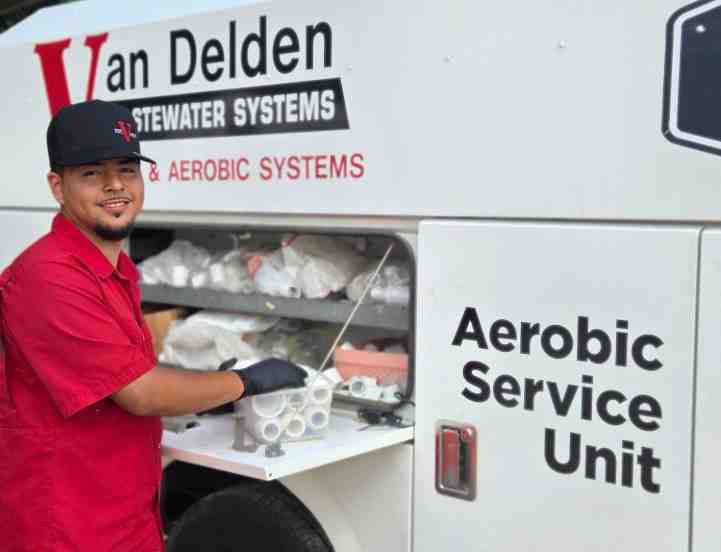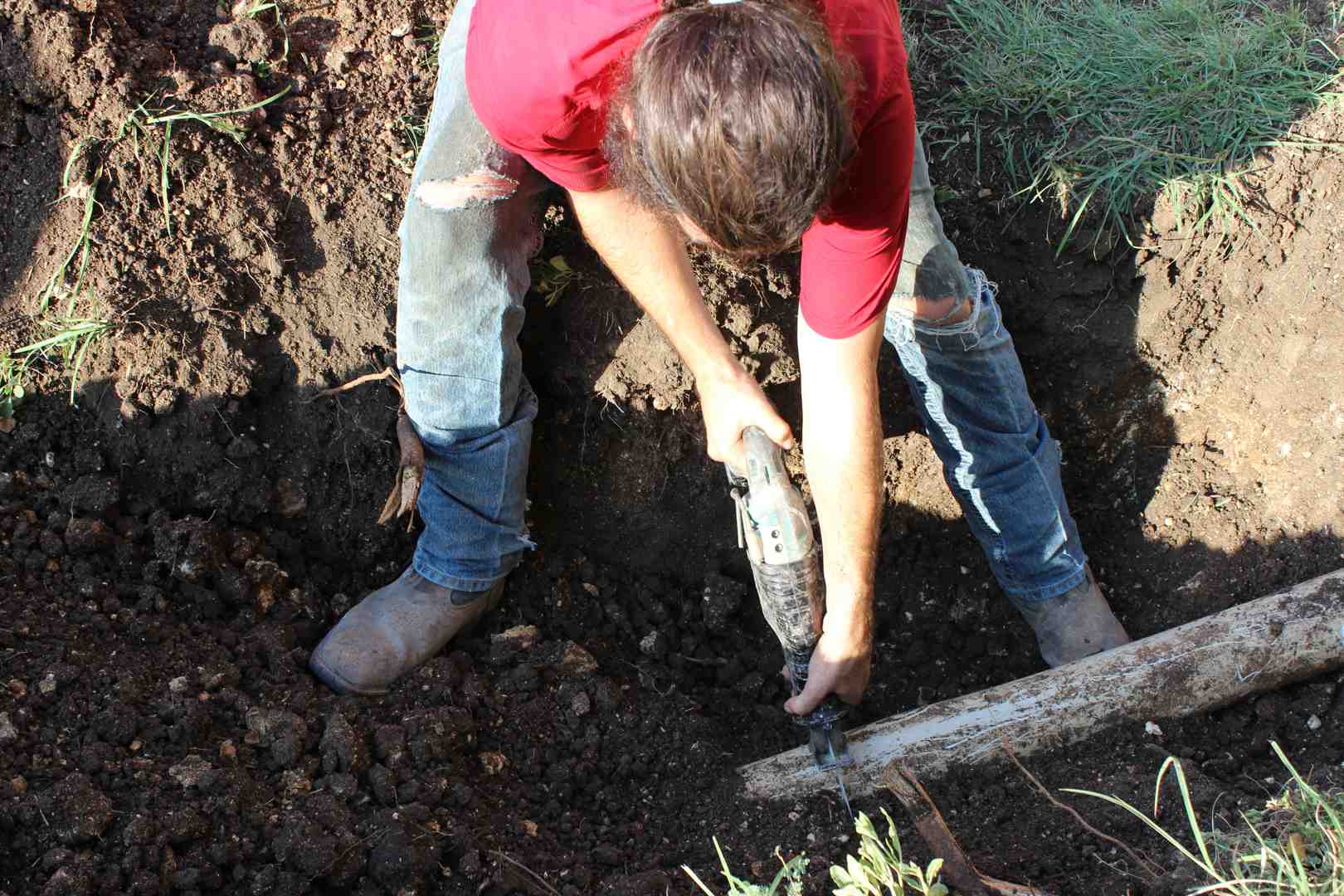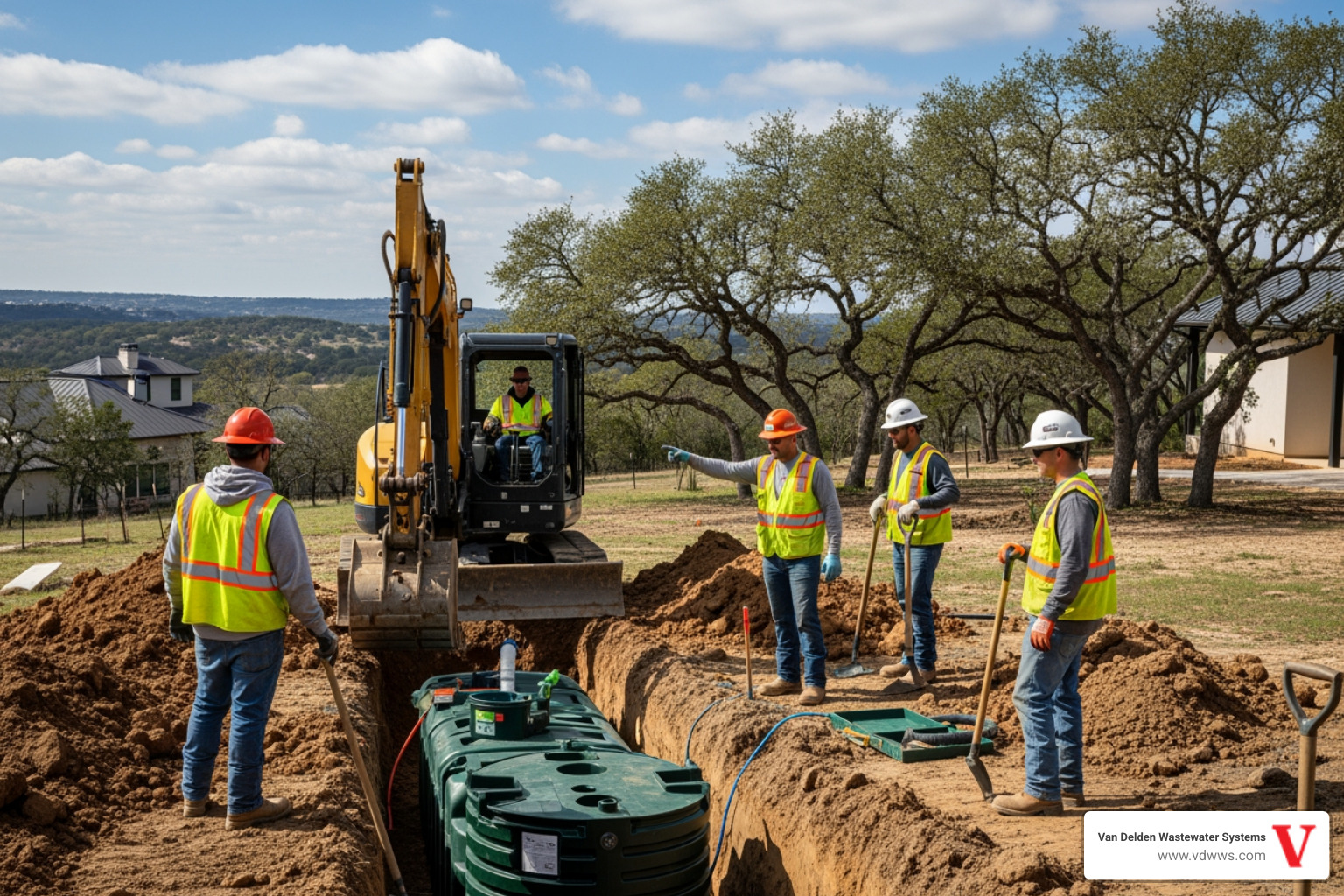Why Every Homeowner Needs to Know Their Septic Tank Lid Location
Finding septic tank lid access is one of those homeowner tasks that seems simple until you're standing in your yard with a shovel, wondering where to start digging. Whether you need routine maintenance or face an emergency backup, knowing exactly where your septic tank lid sits can save you time, money, and a lot of frustration.
Quick Answer: How to Find Your Septic Tank Lid
- Check property records - Look for as-built diagrams or septic permits
- Follow your sewer line - Trace the main drain pipe 10-25 feet from your house
- Look for visual clues - Greener grass, depressions, or faster snow melt
- Use a metal probe - Test soil resistance every few feet in suspected areas
- Call professionals - Electronic locating equipment finds buried lids quickly
Most septic tank lids are buried 1 foot deep on average, but they can range from 4 inches to 4 feet underground. Modern systems typically have two lids (inlet and outlet), while older tanks from before 1975 often have just one central access point.
The reality is stark: septic tanks need pumping every 3-5 years, and emergency situations don't wait for convenient timing. Many homeowners find their lid location crisis during winter when the ground is frozen, or when sewage is already backing up into their home.
"Problems with a septic tank can come in many shapes and sizes, and knowing how to find a septic tank lid can save you some frustration," notes one septic professional. That frustration often turns into expensive emergency service calls when you can't direct technicians to the right spot.
Never attempt to remove a septic tank lid yourself. The dangers include toxic sewer gases that can cause serious health issues, plus the very real risk of falling into an open tank. Leave the actual lid removal to trained professionals who have proper safety equipment.
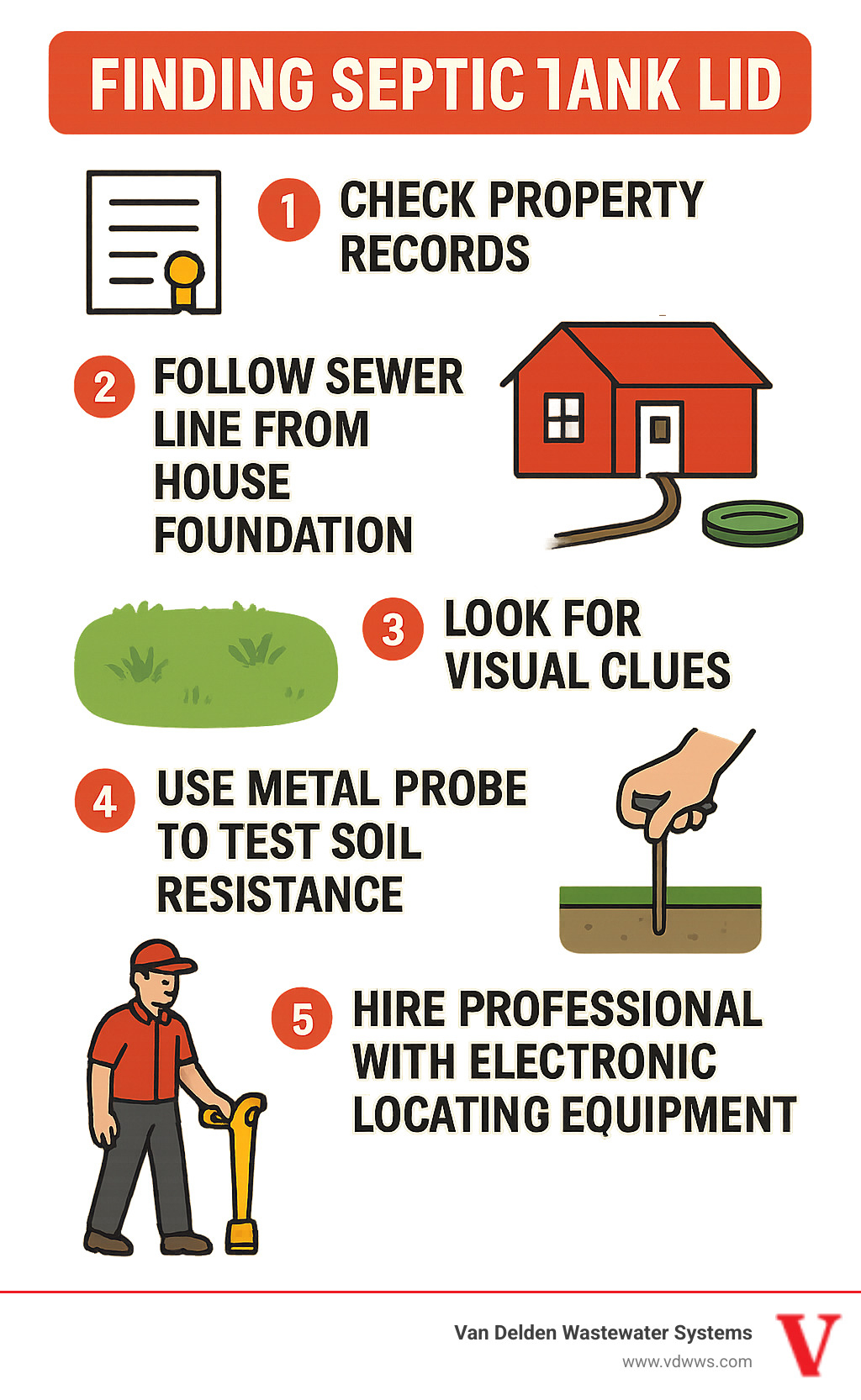
Why Locating Your Septic Lid is Non-Negotiable
Finding septic tank lid access is essential for any homeowner with a septic system. It's as critical as knowing where your main water shut-off valve is—you'll be grateful you found it before a crisis hits.
Your system requires routine maintenance, specifically pumping every 3-5 years. When a technician arrives, their first question is "Where's the access?" If you can't show them, you'll pay for their time to locate it. Knowing the location also simplifies routine inspections, helping to prevent system failure by catching small problems before they become sewage backups.
This knowledge also helps you avoid costly mistakes. Parking vehicles over a tank can cause it to collapse. When planning landscaping projects, you can avoid planting trees with aggressive roots near lines or building structures that block access. Most importantly, it's about emergency preparedness. During a backup, every minute counts. Quick access means a faster resolution, saving time and money. Professional service calls become more efficient when technicians can get straight to the problem.
Understanding Septic Lid Types and Depths
Before you search, it helps to know what you're looking for. Septic lids vary, and understanding the types can guide your strategy.
| Feature | Concrete Lids | Plastic/Fiberglass Lids |
|---|---|---|
| Weight | Very heavy, often requires multiple people or tools | Lightweight, typically easy for one person to lift |
| Durability | Extremely durable, can last 40+ years | Durable, typically last 20-25 years |
| Material | Precast concrete, often with steel rebar | High-density polyethylene or fiberglass |
| Appearance | Gray, often blends with soil, may have rebar | Green or black, sometimes with a textured surface |
| Accessibility | Can be difficult to remove without specialized tools | Generally easier to remove |
| Common Use | Older tanks, or newer large-capacity tanks | Newer residential tanks, easier for installation |
Concrete lids are durable but very heavy. These gray slabs often contain rebar reinforcement, which helps metal detectors locate them. Plastic lids are lighter but can be harder to find with a metal detector unless they have metal hardware.
Modern two-lid systems are now standard, with one lid over the inlet and another over the outlet for thorough maintenance. If your home was built before 1975, you might have an older single-lid system with one central access point.
Lid depth varies widely, from 4 inches to 4 feet underground. The average depth is around 1 foot, but years of landscaping and soil changes can bury lids much deeper.
The Dangers of DIY Lid Removal
While DIY projects are great, septic tank lid removal is absolutely not one of them. This is a critical safety warning.

Septic tanks contain toxic sewer gas, an invisible killer. This includes hydrogen sulfide, which can cause dizziness, nausea, or even be fatal in higher concentrations. Sewer gas can cause serious health issues.
The risk of falling into an open tank is another very real and serious danger. An open septic tank is a serious danger. Furthermore, heavy concrete lids can cause severe injury if they slip during removal.
These are confined space hazards that require professional handling. Technicians have specialized training and safety equipment like gas monitors and ventilation gear. At Van Delden Wastewater Systems, our team follows strict safety protocols. Septic Tank Safety Risers and Safety Pans Save Lives—and so does leaving lid removal to the experts. Your job is to locate the lid; our job is to open it safely.
Best Methods for Finding Septic Tank Lid
Now that we understand why finding septic tank lid access is so important and why caution is paramount, let's explore the best methods for locating this elusive part of your septic system. This detective work combines records, observation, and the right tools to narrow down the search. Most homeowners can successfully locate their lid using these proven techniques.
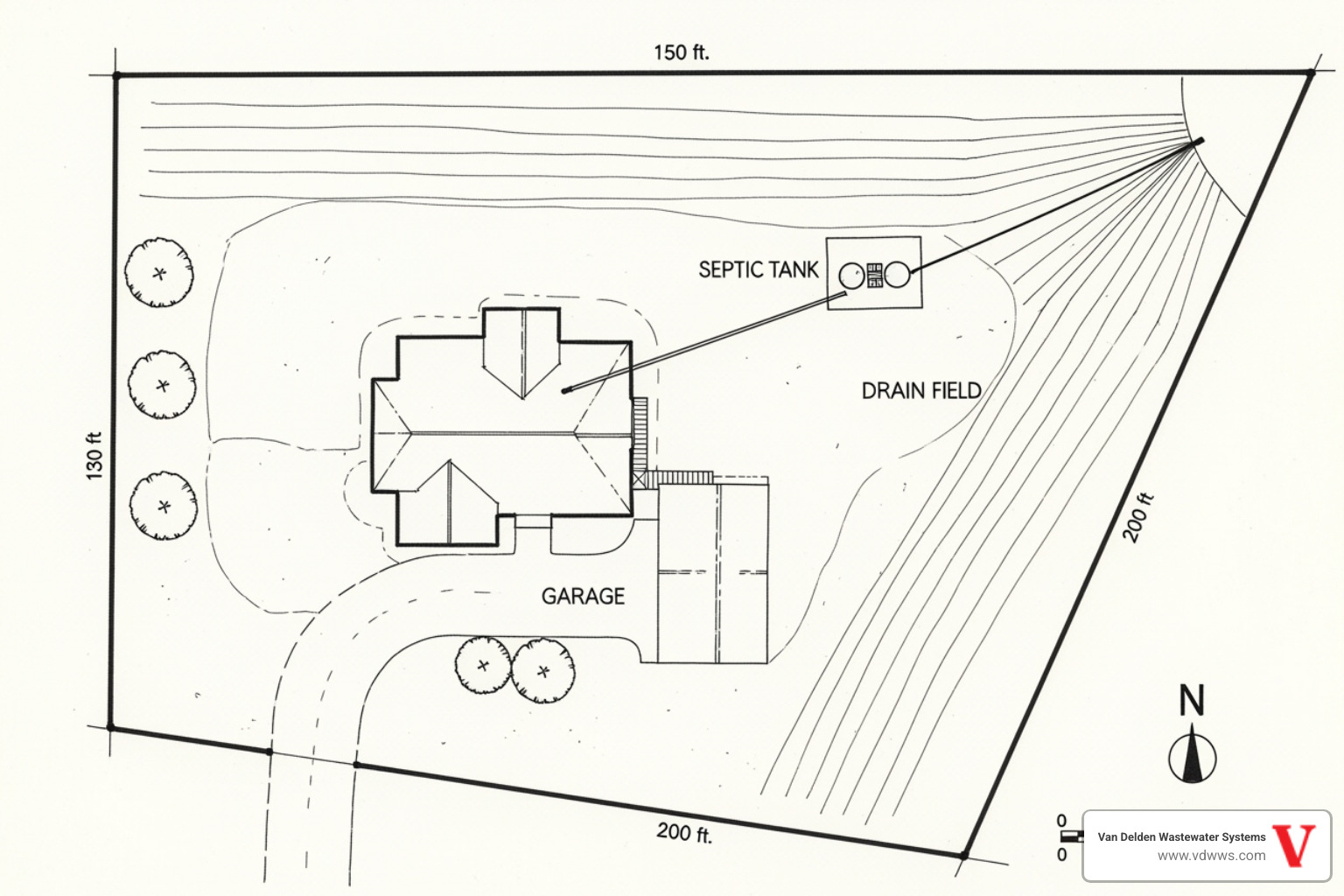
Start with the Paper Trail
Before you start digging, check for existing records that may pinpoint your tank's location.
Property records and as-built diagrams are your best bet. An "as-built" diagram, often included in your home's closing documents, shows the property layout and septic tank location. If you can't find it, contact your county health department or building department, as they often keep these diagrams on file for septic installations. Also, check with previous homeowner records if possible; they may have kept maintenance receipts or a hand-drawn map. Septic system permits, like building permits, are another valuable source and often include diagrams.
Follow the Clues from Your House
If you have no records, the most reliable physical clue is your main sewer line.
Start in your basement or crawlspace to find the large (typically 4-inch) pipe that collects wastewater. Trace this main line to where it exits your home's foundation. Outside, note this pipe exit point. Septic tanks are usually located in a straight line from this point, about 10 to 25 feet away from the house and rarely closer than 3 feet.
Wastewater flows downhill, so your tank will likely be on a downhill slope from the sewer exit point. This can help you determine the most likely direction. A cleanout access point near the foundation can also help you trace the pipe's path.
Become a Yard Detective
Your yard itself might be dropping hints about your septic system's location. These subtle signs can significantly narrow your search area.
- Greener grass patches are one of the most common giveaways. The nutrients and moisture from your septic system can create more fertile conditions, leading to lusher grass growing directly above the tank or drain field.
- Keep an eye out for depressions or mounds in your yard. Over time, soil above a septic tank can settle slightly, creating low spots. Conversely, previous excavations might have left small mounds.
- In colder climates, faster snow melt over your septic tank is a real phenomenon. The biological activity inside the tank generates warmth, causing snow directly above it to melt more quickly.
- Don't forget to look for any vent pipe locations. Some septic systems have small vent pipes extending above ground that are direct indicators of your system's presence.
Use the Right Tools
After gathering clues, you can use simple tools to pinpoint the location. But first, call 811 before you dig. This free service marks underground utility lines to prevent dangerous and costly accidents.
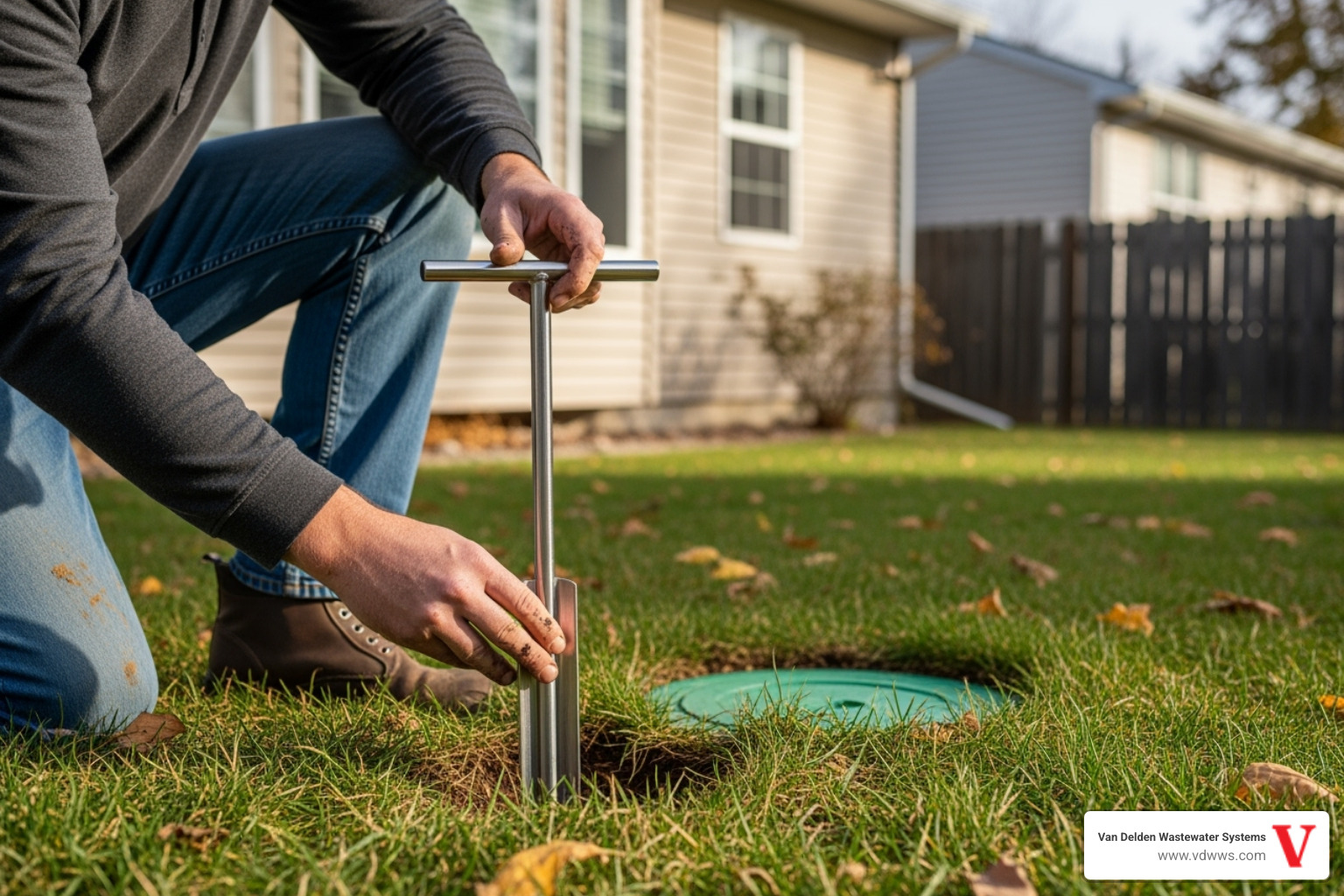
A metal probe (or soil probe) is an effective, affordable DIY tool for finding septic tank lid locations. This slender rod with a T-handle lets you gently push into the ground and feel for the solid resistance of the tank or lid. Probe in a grid pattern in your suspected area, typically 10 to 25 feet from the house. When you hit something solid, probe around it to determine its size and shape. The difference in soil resistance is usually quite noticeable.
If you have an older tank with rebar in concrete lids or a steel tank, a metal detector can be very useful. Sweep the suspected area and mark spots with the strongest signals. This method won't work for all-plastic systems but is excellent for older concrete tanks. When you think you've found it, dig gently to avoid damaging the lid or system components.
You've Found the Lid - Now What?
Congratulations! You've successfully completed the finding septic tank lid mission. But before you celebrate with a victory dance in your yard, there's more work ahead. Think of this moment like finally locating your car keys – the real value comes from making sure you never have to go through that frantic search again.
The next steps are all about setting yourself up for success in the future. You want to transform this one-time findy into a permanent solution that makes septic maintenance as easy as checking your mailbox.
Maintaining Your Septic Tank Lid After Finding It
Your first priority should be marking the location in a way that's both practical and permanent. We've seen too many homeowners go through the entire search process again just six months later because they forgot to mark their find properly.
Decorative rocks make excellent markers – they're heavy enough to stay put, visible enough to remember, and attractive enough that your neighbors won't wonder what you're up to. A small garden statue or even a flag can work just as well. The key is choosing something that won't disappear during your next landscaping project or get moved by well-meaning family members.
Whatever marking system you choose, make sure it doesn't interfere with future access. Avoid planting anything with deep or aggressive root systems near the tank. Those roots can cause serious damage to your septic system over time, turning your smart marking strategy into an expensive mistake.
Mowing and weeding around your newly finded lid area should become part of your regular yard maintenance routine. Keep the grass trimmed and the weeds at bay so the lid stays visible and accessible. This isn't just about aesthetics – overgrown vegetation can hide problems like settling soil or small cracks that need attention.
Regular inspection becomes much easier once you know exactly where to look. While you should never attempt to open the lid yourself, you can certainly keep an eye on the area. Watch for any cracks in the lid, unusual settling of the ground, or strange odors that might indicate a problem brewing below.
Taking care of your septic tank lid is more important than many homeowners realize. We've written extensively about care for septic tank lid in Helotes and why septic lid maintenance is crucial – because a well-maintained lid is your first line of defense against bigger problems down the road.
The Ultimate Upgrade: Installing Septic Risers
If you really want to take your septic system access to the next level, installing septic risers is the ultimate upgrade. Think of risers as bringing your septic tank lid up to ground level permanently – no more digging, no more searching, no more winter excavation nightmares.
Risers eliminate digging completely by extending your tank access points right up to the surface. These durable pipes, typically 12-24 inches in diameter, create a direct pathway from ground level down to your tank openings. It's like installing a permanent staircase instead of using a ladder every time.
The convenience factor for easy access during maintenance cannot be overstated. When our technicians arrive for your routine pumping or inspection, they can get straight to work instead of spending time locating and excavating your lid. This streamlined process often saves time during service calls, and time savings can translate to cost savings for you.
Risers also serve as a visual reminder of your septic system's location. No more worrying about accidentally parking your car over the tank or having landscapers plant something problematic in the wrong spot. The riser acts like a permanent "septic system here" sign that prevents costly accidents.
One of the biggest financial benefits is eliminating cost savings on dig fees. Many septic companies charge additional fees when they have to locate and dig up buried lids. With risers, those fees disappear forever. This is especially valuable during winter months when frozen ground makes excavation difficult and expensive.
Modern risers come in various materials, with polyethylene and PVC being popular choices due to their lightweight nature and superior sealing properties. They're designed to last for decades and can handle everything from lawnmower traffic to normal ground settling.
Installing risers represents a smart long-term investment in your septic system's accessibility and your own peace of mind. We've covered this topic thoroughly in our guides about installing septic risers for better access, the top 3 reasons to install risers, and the role of septic risers in system efficiency.
The bottom line? Once you've gone through the effort of finding septic tank lid access, risers ensure you'll never have to do it again. It's the difference between solving a problem temporarily and solving it permanently.
Frequently Asked Questions about Finding Septic Lids
Over our decades of helping homeowners with their septic systems, we've noticed the same questions come up again and again when it comes to finding septic tank lid locations. Let's tackle the most common ones that might be on your mind right now.
How deep can a septic tank lid be buried?
This is probably the question that surprises homeowners the most. Septic tank lids can be buried anywhere from a shallow four inches to a whopping four feet deep. We wish we could give you a definitive answer, but the reality is that every property is different.
The average depth we typically encounter is around one foot, which is manageable for most homeowners to locate with a metal probe. However, don't be discouraged if yours is deeper. We've seen lids buried much deeper, especially on older properties or homes where significant landscaping changes have occurred over the years. Sometimes previous owners added topsoil for gardening projects, or natural settling has occurred over decades.
The depth often depends on when your system was installed and local building codes at the time. This variability is exactly why the visual clues and probing techniques we discussed earlier become so crucial in your search strategy.
Are there always two lids on a septic tank?
Here's where the age of your home really matters. Modern septic tanks typically have two lids that provide access to both the inlet baffle (where wastewater enters from your house) and the outlet baffle (where partially treated water exits to your drain field). This two-lid design allows our technicians to thoroughly pump and inspect both compartments of the tank during routine maintenance.
However, if your home was built before 1975, you might find that your older septic tank has only one central lid. This was the standard design back then, though it does make comprehensive maintenance a bit more challenging. Don't worry if you only find a single access point on an older system – that's completely normal and expected.
The two-lid system became more popular as we learned more about septic system efficiency and maintenance requirements. If you have an older single-lid system, it's still perfectly functional, though you might want to consider upgrading when the time comes for major repairs.
When should I call a professional for finding septic tank lid?
We always encourage homeowners to try the DIY methods we've outlined first – checking property records, following visual clues, and using a metal probe. These steps can save you money and give you valuable knowledge about your property. However, there are definitely times when calling professionals like us makes the most sense.
You should call a professional if you've exhausted all the DIY methods we've discussed and still can't locate your septic tank lid. We have specialized electronic locating equipment that goes far beyond what's available to most homeowners. This includes flushable transmitters and receivers that can precisely pinpoint your tank's location, even if it's buried deep or in an unexpected spot.
If you suspect the lid is buried deeper than you can safely dig, it's definitely time to bring in the experts. We have the proper excavation tools and safety equipment to handle deep or difficult excavations without damaging your property or the septic system itself.
Experience matters when dealing with tricky situations. We've encountered tanks hidden under decks, driveways, and even dense landscaping that's grown up over decades. Our technicians are trained to spot subtle clues and interpret property layouts that might not be obvious to an untrained eye.
Safety should always be your top priority. If you find what you think might be a damaged lid, or if you encounter any unusual odors or conditions during your search, stop immediately and call us. We have the proper safety equipment and protocols to handle these situations safely.
The investment in professional locating services typically pays for itself in peace of mind and accuracy. Plus, once we find your lid, we can help you implement long-term solutions like septic risers that will eliminate the need for future location services entirely.
Conclusion
Finding septic tank lid access isn't just another item on your homeowner's to-do list – it's your ticket to avoiding costly emergencies and keeping your septic system running smoothly for decades to come. Think of it like knowing where your home's main water shut-off valve is located. You hope you'll never need it in a crisis, but you'll be incredibly grateful when you do.
Throughout this guide, we've walked through the detective work involved in locating your septic tank lid, from digging through old property records to becoming a yard sleuth looking for greener grass patches and subtle ground depressions. We've covered the practical tools that can help, like metal probes and detectors, while emphasizing the critical importance of safety first. Once you find that lid, the actual removal should always be left to trained professionals who have the right safety equipment and expertise to handle toxic gases and heavy concrete lids.
The key takeaways are straightforward: know your system, prioritize safety, and think proactively about maintenance. Whether you're preparing for routine pumping every 3-5 years or facing an unexpected backup, having that lid location marked and accessible can save you significant time, money, and stress.
For the ultimate upgrade, septic risers are a game-changer that eliminates future digging and makes your system easily accessible year-round. It's an investment that pays for itself in convenience and eliminated dig fees over the life of your system.
As a family-owned business that's been serving Texas homeowners since 1937, Van Delden Wastewater Systems understands that septic systems work best when they're properly maintained and easily accessible. Our honest, background-checked technicians take pride in educating customers and providing quality work with detailed documentation, serving communities throughout Boerne, Bulverde, Fair Oaks Ranch, Garden Ridge, Helotes, Timberwood Park, Hollywood Park, San Antonio, Shavano Park, Spring Branch, and beyond.
When you're ready for professional help – whether it's locating that elusive lid or installing risers for permanent easy access – explore our septic lid and riser services. Let us help you uncover your septic secrets and keep your system running smoothly for years to come.
Customer Reviews
Peter was personable, professional and thorough. Highly recommend Van Delden. You might be able to find a cheaper company but not better!
On time. 100% professional, knowledgeable, and courteous. Very helpful and straightforward. That is the bar all businesses should strive for.
It has been a pleasure working with your company. Not only did y’all communicate very well but your workers were always polite! Thank you!
“I thank Van Delden for such prompt service. Honest people are hard to come by these days. I will certainly recommend Van Delden to anyone! Jesse is an upstanding young man and very nice to talk to. I thank everyone at Van Delden for taking such good care of me.”
This is just a note to thank you for explaining the problem with my system. You didn’t have to be so kind and I appreciate your good business ethics and time spent. In the future you will have mine in return!



